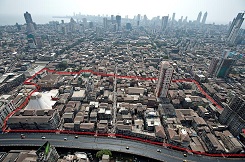By Qureish Raghib* | IDN-InDepth NewsFeature
MUMBAI (IDN) – From being an irrigation tract in its early days to being developed by the British to resettle communities – affected by the Great Mumbai Fire that broke in 1803 at the Fort area – and then eventually mushroom into a bustling business district, Bhendi Bazaar in India’s South Mumbai, has come a long way in terms of socio-economic evolution.
The market area derives its name from a plantation of thespesia populnia or bhendi in the north-west of Dongri as mentioned in the Maharashtra State Gazette. Surprisingly, even with its 200-year-history of characteristic entrepreneurial resilience, Bhendi Bazaar gradually sunk in an abyss of civic neglect and infrastructural despair leading it to be seriously challenged in a liberal Indian economy.
But interestingly, even during the global economic slowdown that affected Indian market growth in the last decade, this large area having distinct business dynamics, undertook economic reforms such as diversification and new business ventures while indulging in minimal credit facilities.
This has been largely possible as over 50% of the 1250 commercial establishments in the project area are owned by Dawoodi Bohras – one of the oldest mercantile communities that first settled in the city during the 18th century.
Known for their business acumen, Dawoodi Bohra businesses in Bhendi Bazaar and elsewhere have grown exponentially by benefitting from the Burhani Qardan Hasana Trust, a global financial institute established by the community’s spiritual leader His Holiness Dr. Syedna Mohammed Burhanuddin. The trust facilitates short and long-term interest-free credit disbursement, which in turn, helped in arresting larger effects of recession, and facilitated capital inflow in the area.
Apart from the traditional business of hardware tools, artifacts bazaar, the Friday flea market, there has been an increase in pilgrim tourism due to the religious and cultural centers situated in the area like the world renowned Raudat Tahera, the mausoleum of Syedna Taher Saifuddin.
Taking into consideration all these socio-economic dynamics, mainstream market players particularly from the service and hospitality sectors along with small manufacturers have put-up outlets in the area providing job opportunities and alternate source of income to many a household in Bhendi Bazaar.
However, be it petty shopkeepers or value added service providers depending on elite clientele or businesses requiring spacious floor-space – all macro and micro market players have been adversely affected due to diminishing urban facilities in the vicinity.
‘Constrained optimization’
With an overall 74% ground coverage, the present 66,264.74 Sq. m. area has a rather high population density in South Mumbai. Interestingly, the newly proposed Bhendi Bazaar re-development project undertaken by the Mumbai based Saifee Burhani Upliftment Trust ( SBUT) will have a 54.55% ground coverage post redevelopment. The project, according to the mainstream economic theory, is constrained optimization. It represents arriving at a set of best solutions to a matrix of problems.
From a purely economic perspective, the non-profit redevelopment initiative in the area would shift the perfectly inelastic supply curve of commercial and residential land to the right. This would lead to an increase in consumer surplus to the residents and additionally provide positive externalities to the surrounding areas such as over 15 m wide internal peripheral roads for vehicular movement, separate loading-unloading facilities for commercial vehicles and 1,16,153.93 Sq m of much needed parking facility in the area.
It is fascinating to note that Bhendi Bazaar’s parameters of economic growth are largely defined on the lines of the area’s cultural and social vibrancy. The fact of the matter is, while all religious and cultural architectural structures situated in the vicinity are to be retained, all legitimate businesses and cosmopolitan residents would also be relocated back in the same locality.
Moreover, unlike the present inequitable market scenario, both complementary and substitute goods’ stakeholders in the neighborhood are to be provided with shops strategically facing the main roads making it Mumbai’s longest high-street shopping area.
All these factors in the economic evolution of Bhendi Bazaar eventually serve the multiple purpose of retaining to a great extent the local cultural flavor, reinstate the traditional bazaar essence while it provides a contemporary business environ, and reinforce Bhendi Bazaar’s past business glory.
There is apparently an absence of a quality shopping area catering to the simultaneous needs of all strata of the society in a three kilometer radius around the proposed Rs. 3000 crore (US $545.45 million) Bhendi Bazaar re-development site. With an average 100,000 footfall registered today, a conservative approximation of a three-fold commerce and trade growth would appear to be a reasonable prediction taking into account a much broader customer base expected in the post-redevelopment phase.
Subsequently, economic stimulus will be by way of employment gains, leveraged investment, and revitalized neighborhoods while fiscal impacts would include generating new sources of local revenue derived from previously less productive establishments.
A small minority has expressed reservations advocating the need to preserving the “natural fabric of the city”. But it does not have any credible solutions to offer in correcting the colonial era’s deteriorating long, linear stretches that constitute this area.
At stake are 80% of buildings that suffer from dangerous dilapidation and constant repairs, compounded with critically congested 150-year old arterial roads. All this posea serious risk to human life and property. The question that begs to be answered is whether or not the residents of Bhendi Bazaar have a right to a better quality of life as their forefathers did a century ago?
*The writer is a Mumbai based writer on current socio-economic affairs in South Asia. [IDN-InDepthNews – June 21, 2013]
2013 IDN-InDepthNews | Analysis That Matters
Image: Bhendi Bazaar aerial view
Send your comment | Subscribe to IDN newsletter
Follow us on Twitter and Facebook:
http://twitter.com/InDepthNews
http://www.facebook.com/IDN.GoingDeeper

